Site Menu:
| This is an archived Horseadvice.com Discussion. The parent article and menus are available on the navigation menu below: |
| HorseAdvice.com » Diseases of Horses » Lameness » Muscle & Tendon Diseases » Tendon Laxity and Contracture » |
| Discussion on Tendon Laxity Miniature Foal | |
| Author | Message |
| New Member: minikim |
Posted on Saturday, Feb 7, 2009 - 7:55 pm: I have a miniature horse foal born 5 days ago that has bad legs and was just wondering if it was best to keep her stabled all the time or could I let her out for a small run for a short time with her mum in a small size yard. Foal is as bright as can be but mum is going crazy being stabled so much. Also any thoughts on when legs could start to improve???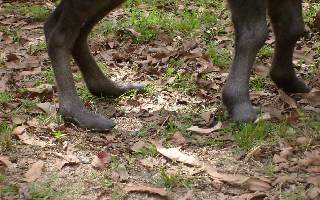
|
| Member: maggienm |
Posted on Saturday, Feb 7, 2009 - 10:02 pm: Welcome Kim, Aw sorry to see your baby like that.I don't have any advice but others will soon. |
| Moderator: DrO |
Posted on Saturday, Feb 7, 2009 - 10:17 pm: Welcome Kim,The photos do not give us enough information to know what the best therapy and management is. What does your veterinarian say? Additional photos from the front, back and other side will help but it requires palpation of the joints to make the correct decisions. More on this is explained in the article. DrO |
| New Member: minikim |
Posted on Monday, Feb 9, 2009 - 7:16 pm: will attach some more pic's of legs nowMy vet has said to keep her stabled for 3 weeks and that it could be caused by the mare having to much protein while in foal?? 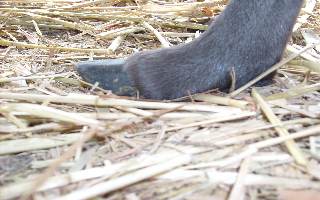
|
| New Member: minikim |
Posted on Monday, Feb 9, 2009 - 7:20 pm: 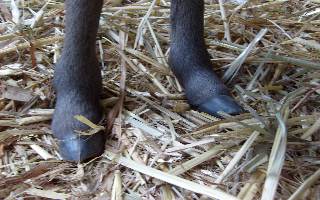 Front veiw |
| New Member: minikim |
Posted on Monday, Feb 9, 2009 - 7:21 pm: 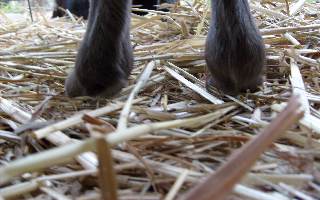 Back view |
| Member: rtrotter |
Posted on Monday, Feb 9, 2009 - 8:03 pm: Kim,My 2008 Arturo foal was born with hind legs similar to your foal, one worse than the other. His front legs were better but not much. in his first month he was given limited exercise to strengthen his legs slowly ( only an hour or two that was gradually increased) and he wore foal hoof extensions on 3 of four feet. If you were to look at him now, you would not be able to tell that anything was ever wrong. He actually has very good conformation and all his legs are fine. Early intervention is the key here and I think you and your vet have it right ( although I would question why this little guy has to be stall bound 24/7). Can't he go out to play just a little? Good Luck with him. Rachelle |
| Moderator: DrO |
Posted on Tuesday, Feb 10, 2009 - 9:07 am: Hello Kim,Though drawing conclusions from one time static photos can be misleading I think I see improvement in the back legs already. Are you taking the foal out for short little walks? I disagree with the assessment of too much protein during gestation. Do you know what your mares levels were? Experiments have looked at the effect of high levels of protein (up to 30% of the diet) during gestation and adverse health effects were not noted in the newborn foals. The little we know about the causes is listed in the article. DrO |
| New Member: minikim |
Posted on Tuesday, Feb 10, 2009 - 4:35 pm: I would not think protein to be the problem either as it is summer time her in Oz so she was left to graze only getting small chaff and pellet feed in morning and then grass hay of night.Was thinking more along the lines of maiden mare and not enough room for the foal in the womb so that it was more tucked up in there maybe???? I am going to let the mare and foal out of the stable into a small holding yard today for a short while so they can have a move around. Thank you for your help with this as greatly needed. I have heard of others that have had hoof extensions done so was wondering when these are put on and if done by a vet or farrier?? my vet said he would think after 3 weeks there was no improvement then he would maybe have to do an op but did not say what was involved in doing so Thanks again Kim |
| Member: rtrotter |
Posted on Tuesday, Feb 10, 2009 - 7:33 pm: Kim,My colt's hoof extensions were done by a farrier that specializes in corrective foal shoeing. If I remember right, once he started to get some exercise his legs started to look better. The foal extensions were put on to support his legs and keep the one really bad leg from twisting too much. I do not think he was more than 10 days to two weeks old when the farrier put them on. He wore them for 6 weeks with a new set after 3 weeks. The last set was on him until they were completely trimmed away. By that time, his legs looked normal and he has continued to grow normally. As for cost, each set was around three hundred dollars, maybe for a mini it might be less (or more because its so specialized). My colt was at a breeding farm when this was done, so if I was going to search for a farrier to do this, I would call the breeding farms in the area first to see if they knew of someone that had the experience to do it correctly. I'll bet mom and baby will be very glad to get out. Rachelle |
| Moderator: DrO |
Posted on Wednesday, Feb 11, 2009 - 6:38 am: We just do not know why this happens sometimes Kim, I know that is frustrating but it is better to realize this rather than fish for reasons that may lead to bad decisions, like decreasing the protein of a adequate dietary regimen. Be sure to post us picture when those legs straighten up.DrO |
| New Member: lgill |
Posted on Wednesday, May 27, 2009 - 8:22 am: You can always use Dynasplint Systems to correct angular & flexural limb deformities in your foals or older horses.https://www.dynasplint.com/division/veterinary.php Dynasplint Systems is used to correct angular and flexural limb deformities in small and large animal. In a very gentle, non-invasive way, the bilateral tensioning system within each Dynasplint System is able to correct the following problems: a) carpal contractures; b) carpal hyperextensions; c) fetlock contractures; d) fetlock laxities; c) deep digital flexor tendon contractures; d) upright pasterns; e) valgus/varus carpals, tarsals, & fetlocks; f) any loss of range of motion due to surgery, lacerations, or congenital problems; g) as well as many other lower limb issues. 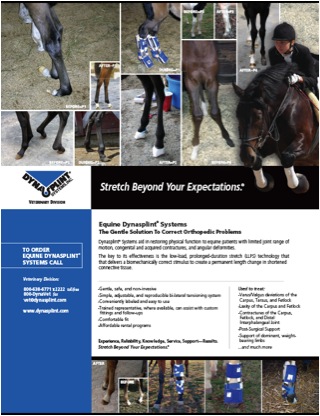
|
| Member: sodmonst |
Posted on Wednesday, May 27, 2009 - 10:25 am: lgill, are you a sales rep for this company? I notice that you have posted this add in more than one thread. |
| Member: sodmonst |
Posted on Wednesday, May 27, 2009 - 10:32 am: Oh, I see that you are a salesperson,. Igill, when I see these advertisements without disclosure of the commercial motive, I feel annoyed. |
| Member: lgill |
Posted on Wednesday, May 27, 2009 - 10:43 am: I am so sorry!! I am new to HorseAdvise, and I did not realize that I was speaking out of turn. I just joined late last night and have been studying about ALDs and such. So sorry!! I have asked the administrator to remove my posts. Hope y'all have a great day. |
| Member: sodmonst |
Posted on Wednesday, May 27, 2009 - 10:48 am: Welcome to the site. I hope that this rocky start is not the last we hear from you. Your product is interesting, maybe this will help.https://www.horseadvice.com/horse/messages/2/5627.html It tells about horseadvice.com options for classified adds and information publishing. 
|
| Moderator: DrO |
Posted on Thursday, May 28, 2009 - 10:05 am: We should note that splinting is not indicated in cases of laxity like that described above. The support of lax musculo-tendonous structures tends to increase laxity not help it.DrO |
| New Member: peggymc |
Posted on Wednesday, Jun 2, 2010 - 9:48 pm: I wish I had seen Dr. O's article and advice for my baby foal several weeks ago. He had lax tendons, and was put out without bandages because I wasn't told sores would quickly develop. He wound up with septic arthritis, which did not respond to antibiotics and was put down today. By the time I learned about Elasticon, which worked great, he already was starting toward open sores. Please take Dr. O's advice, bandage even if the foal is in the stall. Watch your foal when turned out to be sure the bandages are holding. If you put vet wrap under the Elasticon, which is very sticky, it will be much easier to take the Elasticon off without tearing at your foal's hair and skin. |
is The Horseman's Advisor
Helping Thousands of Equestrians, Farriers, and Veterinarians Every Day
All rights reserved, © 1997 -
